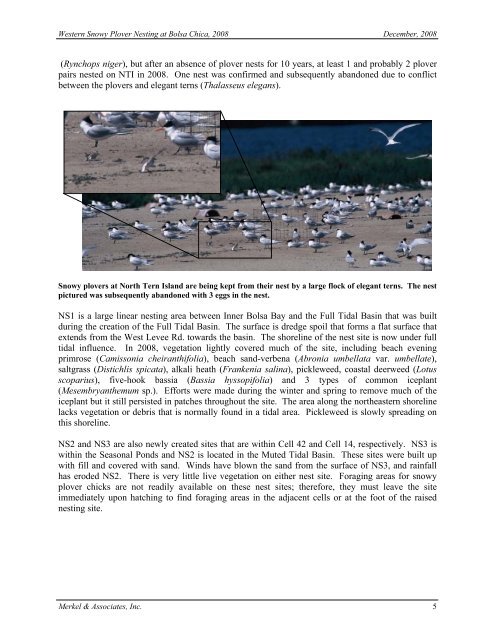2008 Annual Monitoring Report (pdf 10.9MB) - Bolsa Chica ...
2008 Annual Monitoring Report (pdf 10.9MB) - Bolsa Chica ...
2008 Annual Monitoring Report (pdf 10.9MB) - Bolsa Chica ...
Create successful ePaper yourself
Turn your PDF publications into a flip-book with our unique Google optimized e-Paper software.
Western Snowy Plover Nesting at <strong>Bolsa</strong> <strong>Chica</strong>, <strong>2008</strong> December, <strong>2008</strong><br />
(Rynchops niger), but after an absence of plover nests for 10 years, at least 1 and probably 2 plover<br />
pairs nested on NTI in <strong>2008</strong>. One nest was confirmed and subsequently abandoned due to conflict<br />
between the plovers and elegant terns (Thalasseus elegans).<br />
Snowy plovers at North Tern Island are being kept from their nest by a large flock of elegant terns. The nest<br />
pictured was subsequently abandoned with 3 eggs in the nest.<br />
NS1 is a large linear nesting area between Inner <strong>Bolsa</strong> Bay and the Full Tidal Basin that was built<br />
during the creation of the Full Tidal Basin. The surface is dredge spoil that forms a flat surface that<br />
extends from the West Levee Rd. towards the basin. The shoreline of the nest site is now under full<br />
tidal influence. In <strong>2008</strong>, vegetation lightly covered much of the site, including beach evening<br />
primrose (Camissonia cheiranthifolia), beach sand-verbena (Abronia umbellata var. umbellate),<br />
saltgrass (Distichlis spicata), alkali heath (Frankenia salina), pickleweed, coastal deerweed (Lotus<br />
scoparius), five-hook bassia (Bassia hyssopifolia) and 3 types of common iceplant<br />
(Mesembryanthemum sp.). Efforts were made during the winter and spring to remove much of the<br />
iceplant but it still persisted in patches throughout the site. The area along the northeastern shoreline<br />
lacks vegetation or debris that is normally found in a tidal area. Pickleweed is slowly spreading on<br />
this shoreline.<br />
NS2 and NS3 are also newly created sites that are within Cell 42 and Cell 14, respectively. NS3 is<br />
within the Seasonal Ponds and NS2 is located in the Muted Tidal Basin. These sites were built up<br />
with fill and covered with sand. Winds have blown the sand from the surface of NS3, and rainfall<br />
has eroded NS2. There is very little live vegetation on either nest site. Foraging areas for snowy<br />
plover chicks are not readily available on these nest sites; therefore, they must leave the site<br />
immediately upon hatching to find foraging areas in the adjacent cells or at the foot of the raised<br />
nesting site.<br />
Merkel & Associates, Inc. 5






